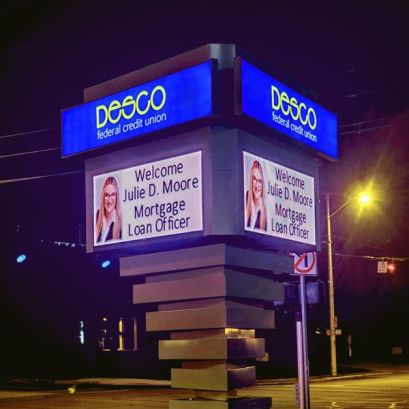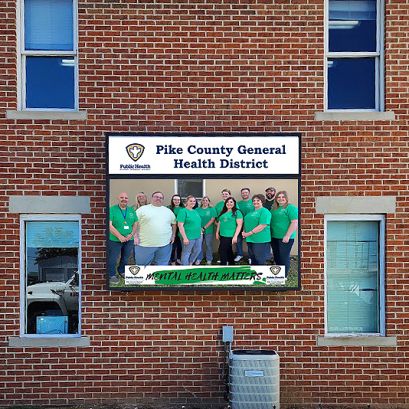ELECTRONIC MESSAGE CENTERS
Contents• EMC Pricing: A Big Board Doesn’t Necessarily Mean Big Price Tag
• How EMC Clarity is Measured
• Is The EMC You’re Considering Bright Enough or too Bright? NIT Knows
• EMC Communication And Security: Just the facts, Ma’am
• Electronic Message Center Warranties and Warnings
Electronic message center (EMC) signage, also known as digital LED message boards or programmable LED Signs have been a gamechanger in the way businesses and organizations communicate with their audiences. There’s a host of reasons why this is the case, but the main benefit is their ease of use in adding, deleting and moving messages.
Gone are the days of laboriously changing letters on a static sign. With EMCs, adding, deleting, and moving messages is as simple as a few clicks on a computer or mobile device. This flexibility allows businesses to quickly update their promotions, announcements, or event details in real time, ensuring that customers are always in the loop.
Fresh messaging literally requires nothing more than a few keystrokes. Thus, the automation of content management saves employees time freeing them for more profitable work which aids in improving the bottom line.
Keeping content fresh and up-to-date is absolutely necessary for capturing attention in today’s fast-paced world. By incorporating bright colors along with animated and/or video elements into a message, a business, church or nonprofit can significantly increase viewer engagement. This modern approach transforms the message board into a vibrant focal point, making it hard for passersby to look away. When eyes are drawn like magnets to the content, it creates an opportunity for an entity's message to resonate more effectively.
For businesses, this heightened visibility can directly translate to increased revenue. It helps that modern EMC signage can be programmed to display different messages at different times, enabling businesses to tailor their communications based on the time of day or audience demographics. For example, a restaurant might promote breakfast specials in the morning and transition to dinner offers later in the day. As potential customers in a timely way are captivated by animated promotions or eye-catching announcements about products, services, or sales, they’re more likely to be drawn to make a purchase.
Nonprofits such as churches and schools can also experience revolutionary gains, just as businesses have reported by using LED programmable signage. Vibrant, dynamic content can help communicate an entities’ mission and goals in a way that truly connects it with its audience. This leads to increased attendance at meetings, increased donations and greater support.
By leveraging this engaging modern format of programmable LED sign communication an organization can stand out and inspire its audience, ensuring that its important work gets noticed and reaches the people it’s meant to touch. Overall, embracing modern content strategies isn’t just a trend; it’s a smart investment that spells communication success.
David Williams, the owner of Sun Sign Company, shares this insightful perspective on the versatility and benefits of programmable LED signage among entities with whom he's worked:
“I can’t think of a single business, organization, school, or nonprofit that has worked with us that didn't believe it upped its game substantially by purchasing an electronic message center display. EMCs have proven to be invaluable tools for streamlining communication, allowing those in charge to add, delete or change a board's message from virtually anywhere in the world at a moment’s notice. And, while there is an overall consensus that Digital LED signs turn heads, exposing the message to more eyeballs, 'Wait' as they say, 'There's more!' Programmable LED signs keep audiences informed and engaged - IN REAL TIME. That's the difference! What’s even better is that these modern signage solutions aren’t just for large corporations anymore."
Sun Sign Company offers a range of EMC options that are budget-friendly, making them accessible to smaller organizations, like local church congregations and family-run businesses. This means that anyone can harness the power of EMCs to put their messaging on par with the big boys, and connect with their communities more effectively.
Can you afford to go without Electronic Message Center signage any longer? How much is that costing you?
EMC Pricing: A Big Board Doesn’t Necessarily Mean Big Price Tag
Electronic Message Centers come in many sizes, and can be purchased either as no frills models or fully featured with all the options. But, what determines the price more than any other factor is the clarity of the images the unit is capable of producing. Thus, a fully featured small message board with smooth, clear, full color imaging can cost as much or more than a monocolor message board twice its size void of frills.
Generally speaking, clearer images are derived from having a lot of small LED diodes in a given space. The smaller the diodes are crafted and the tighter that manufacturers pack them against one another, the better the image quality. This setup is ideal for blending colors together to produce color gradations on text and images. It also helps stabilize motion in animations and videos, making the movements on screen appear smooth as opposed to jumpy or jittery. The opposite is also true. A smaller number of larger LED diodes with more space between them results in screen visibility suitable only for text and stick figure animation.
This setup doesn’t mean that monocolor boards with larger than average diodes have no value. While they are somewhat boring to look at compared to their full color counterparts there are many businesses and organizations that rely on simple mono-color boards on a daily basis. Road construction crews use them to convey alternate traffic routes and lane change instructions. Airports use them to give up to the minute information regarding arrivals and departures of aircraft. Gas stations use them to display the latest in fuel pricing.
Industries such as these allow manufacturers to continue to sell a significant number of monochromatic EMCs. Because there continues to be demand for monochromatic displays manufacturers are able to maintain price levels even when other electronic products as a rule get less expensive each year.
But newer and better electronic message centers are also in high demand. Demand for better clarity and higher performing electronics drives manufacturers to constantly improve products and there is no shortage of people wanting the newest and best LED boards. Where only a decade or so ago single color LED diodes were the only choice available, the latest in electronic messaging boards boast capability of producing a color spectrum of trillions of colors.
How EMC Clarity is Measured
There may be thousands of LED diodes in an electronic message center depending on the size. The smaller the LED diode the more that can be crammed into a display. We’ve stated in previous text that the size of an LED diode in an electronic message center plays a role in determining price and clarity. While smaller LED diodes drive up the price, they also drive up the clarity.
It takes varying amounts of red, green and blue to make up the trillions of colors that can be displayed on a full color digital message board. In older displays you can physically see triangular groupings of the three light diodes - one red, one green, and one blue – in rows and columns on the face of display. Now days, these are most often grouped together under a common lens. Loosely stated, the distance between the groupings is known as pixel pitch.
Pixel pitch is perhaps the best measurement for determining clarity on an electronic message center display. It’s the distance between the centers of two adjacent diodes or diode groupings. Pixel pitch is measured in millimeters and determines the clarity or resolution of the image an EMC can display. A smaller pixel size and pixel pitch will produce a higher resolution and sharper image than a pixel size and pitch of a higher value.
For example, EMCs advertising a 10mm pixel pitch will display clearer images than EMCs boasting a 20mm pitch. A 6mm pixel pitch measurement will provide greater clarity in EMCs than a 10mm.
At a far distance and looking straight on at an EMC it might be hard to notice the difference in clarity between larger or smaller pixel pitches. But generally speaking, smaller works best when viewing from a short distance or viewing at an angle. 6mm is a common pixel pitch measurement for viewing at about 20 feet. At 100 feet a 10mm to 16mm pixel measurement might be sufficient. Since smaller pixel measurements result in more expensive EMC displays, our recommendations are always a balancing act between clarity and cost so as to provide the best value we can to our customers.
Another reason EMCs with smaller pixel size and pitch cost more is the density of diodes that can be packed into a given space. A smaller size diode and/or tighter spacing allows for the use of more LED diodes.
Imagine the face of a message board filled with tiny pixel squares that contain RGB diodes that can be individually controlled to display different colors. As these diodes get smaller and the space between them tightens the number of squares that can be fitted into columns and rows on the face of a message board increases. The columns and rows make up a boards matrix.
The matrix on an electronic message center refers to the number of pixels in the display, typically described as the number of pixels horizontally by vertically (e.g., 220x180).
A higher matrix value means more pixels, which translates to better image quality, more lines of text, and more characters per line. The arrangement of diodes in the matrix allows for better resolution and brighter, more vibrant images, making an EMC more eye-catching and effective.
However, packing those smaller LEDS more tightly together isn’t just a matter of cramming in more diodes. It involves a lot of research and development to determine appropriate placement of the diodes as well as a sophisticated, precise, technological slow manufacturing process that results in manufacturers charging more money for displays. But, when a superior visual experience is a must and sharper images and better visibility can’t be compromised, those smaller pixels can be well worth the extra expense!
Is The EMC You’re Considering Bright Enough or too Bright? NIT Knows
Having good resolution and clarity on an EMC is awesome. It lets you put up intriquate images and vibrant video. But if the display can’t overcome the light rays of the sun during it’s brightest hours you wouldn’t be able to see your message very well. That’s where NIT comes in.
NIT is how we measure the luminous intensity of a given unit area. This measurement allows us to know the brightness emitted per square meter from an electronic message board. A higher NIT value means a brighter sign.
But, super bright message centers can be a real pain to approaching traffic at night, blinding drivers and possibly causing traffic mishaps. Moonlight hours require much much less lumination intensity than sunlight hours.
The electronic message center you’re looking for should have a means of either dimming the sign automatically via a daylight sensor, or at minimum allow a setting change in the programming software to dim the sign between certain hours via a timer.
Not all signs have capability built into them to allow dimming. Manufacturers on the bottom end of the spectrum try to split the difference between adequate daylight lumination and tolerable nighttime nit with no other provision for adjusting brightness of the display.
Of the manufactures who have capability of dimming a sign, this is accomplished in a variety of ways through the use of internal or external sensors. Top tier signs have a built-in feature to constantly probe the level of brightness needed day or night. As the software receives the signal it dims or brightens the sign to a sufficient level without overpowering it or underpowering it. This feature is often sold as an energy-saving feature, which it does do, but it’s more about light management than power savings, since LEDs are already relatively energy efficient.
Mid-tier electronic message board signs often have optional add-on units that, when sensing daylight, run the sign at peak power and lumination. Once nighttime falls the sign drops to a lesser power and brightness, staying that way until it it once again senses daylight.
The software you use for programming the sign may or may not allow you to refine the setting via a timer. For example, and if you have the capability, you may be able to set the display on peak power from 11am to 3pm, semi-reduced power from 3pm to 7pm, and even lesser power from 7pm to until 6am where the sign goes back to semi reduced power until peak power is needed again at the 11am hour.
This is an important and an often overlooked feature on electronic message centers.
If your sign will be located near a highly trafficked roadway the ability to control the brightness is something that needs to be considered. In fact, an increasing number of municipalities are regulating the level of brightness that can be displayed on electronic message centers.
Having the ability to use adequate lumination without overpowering signs can save on the electric bill, make your sign easier to look at and read and reduce the risk of blinding oncoming motorists. That’s some really compelling reasons to say “yes” to this option.
EMC Communication And Security: Just the facts, Ma’am
There are a few options through which you can communicate with your sign to add, delete and maneuver messages into particular playlist order. First you’ll need to download software. This is included with most signs but some manufacturers put a time limit on its use.
Imagine having a sign that has worked well for five years and you suspect it may be good for five more, only to find out that your software had a time limit on its use. You can’t access the program and find it is being held for ransom until you cough up a few thousand dollars to renew the communication package subscription? It happens. Not every company is upfront about the true cost of ownership for the duration of the sign. Make sure you have lifelong use of the software or have a reup figure negotiated that you are comfortable with and is documented. As with any software, don’t forget to give it a good password that isn’t easily cracked.
Inside the software, regardless of the brand, you’ll find a content management system. It can be complex, minimalistic or something in between. Most companies offer free training to get you up and running. Some offer to train as many people as necessary for as long as is necessary as long as you own and use the sign.
Complex or not, with a little training and some poking around you’ll figure the software out. If you buy from Sun Sign Company, we’ll help you for free!
But, once you have the playlist you want displayed in the programming software there must be a means of publishing, which simply means, getting your messages out to the sign. Here’s where you have a few more choices.
The most secure method of communication is running a CAT5 cable directly from the Ethernet port on your computer to the Ethernet jack in the sign, preferably through underground conduit. It’s the way we set up EMC communication for banks and credit unions whose security can’t afford to be compromised. We’ll call this Option 1.
Option 2 would be communication via WIFI where your computer is hardwired or networked to an antenna outside your building that has a direct line of site to the sign on which hangs another antenna. You create your messages in the software on your computer and they are electronically transmitted via CAT5 or network communication to the antenna on your building. The two antennas talk and viola, your sign responds by decoding and playing your playlist.
With either of these local communication options it is important to use a special device on the CAT 5 just before it inputs your computer to block communication to the Ethernet port so those with malicious intent can’t unplug the communication port on the sign, tie it into it with another computer, and back-feed to capture your data.
Likewise, with Option 1 or Option 2 you should be aware of this, too. While the software resides on your computer or laptop allowing you to create messages and playlists from any location you have to physically be onsite to plug it in and upload your work product to the sign. Once it is in the sign’s memory it will remain there. You no longer have to have your computer connected. Any time you want to remove your message, add or change a message it is done through the software.
Option 3 is Cloud Communication. With cloud communication you don’t have to be onsite to manage messages. You can add, change or remove them from anywhere in the world. In this setup your sign would have a SIM card much like the one in a smartphone that allows a data provider to access your specific device.
So, along with buying the sign you must choose a data provider and plan for which you pay a monthly, yearly or one-time-lifetime fee. The software isn’t housed on your computer as it is with options one or two. The software resides in the cloud.
To add, change or delete messages on your sign, you go to a cloud web address, put in appropriate credentials to access your account. Once your work is completed and you publish your messages your data provider maneuvers the information from where you are to the sign, through satellites and wires in much the same way you’d send a document from your computer to the computer of another person miles away.
Often we’re asked this question, “Can I add, change or delete messages from a smartphone?” Technically yes if your sign has cloud communication. But, my answer is always the same. In most cases, wouldn’t you rather have a bigger screen so you can see everything on the screen including a message preview in the same window without scrolling? In my experience the small screen on a phone or tablet is cumbersome and restrictive. It would work in a pinch, but it’s not the tool to use everyday, if you have any other web device with a bigger screen.
Electronic Message Center Warranties and Warnings
Sign warranty is pretty straight forward but there are a few things to consider. Most mainstream EMC manufacturers offer a basic three year or five year warranty. Some warrant parts only, others provide warranty on both parts and labor. But you also need to consider who you’ll call for repair if there is a problem.
Think for a moment how disappointing it would be to own a sign needing repair only to find out the only authorized repair dealer is the manufacturer who is located on the opposite coast from you? Or, needing repair parts for a sign purchased three years ago only to hear there are no more on the shelf and the manufacturer is no longer producing that part. That actually happens and with an embarrassing frequency.
Progression in chip manufacturing is changing things rapidly, making electronics items purchased today worthless in a short period of time. Electronics manufacturers are quick to abandon today’s technology to chase the most promising option. But, reputable manufacturers of LED signs provide assurance they will have parts on the shelf to fix a sign for ten years from your purchase date even if they have abandoned dated technology in favor of new and better technology. Not so with all manufacturers.
You should also be aware that some manufacturers have stated conditions that could nullify the warranty on your LED sign.
For example, its important that an EMC be sealed up to prevent water from entering the cabinet. Therefore, if you drill a hole into the cabinet for any reason the manufacturer will likely attribute any failure of the sign to moisture that entered through the hole you drilled.
Another warranty exclusion we see often requires an EMC to be on a dedicated electric circuit. Your warranty can be compromised if you share the power going to the sign with any other device on the same set of wires before or after it reaches the message board power supply.
The point is, be acutely aware of any limitations on use, service, parts and warranty before you make a purchase.




